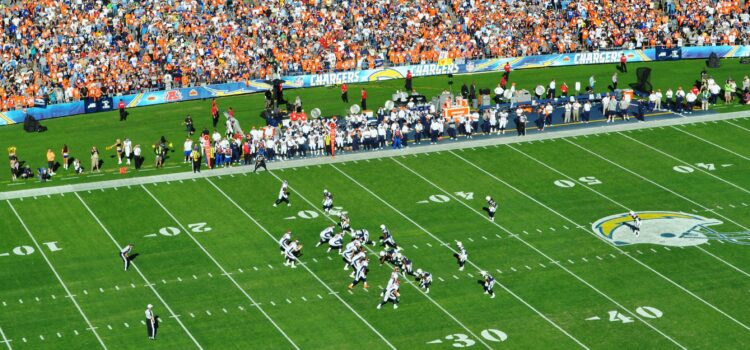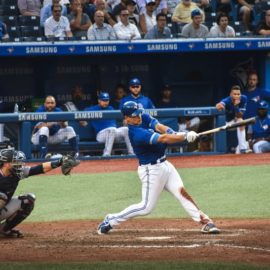

This article is an excerpt from the Shortform book guide to "The Blind Side" by Michael Lewis. Shortform has the world's best summaries and analyses of books you should be reading.
Like this article? Sign up for a free trial here .
Who is Lawrence Taylor in The Blind Side? What is his role in the story?
Though he’s not an actual character in the story, Lawrence Taylor’s The Blind Side role helps set up the premise of the story. Lawrence Taylor was a left tackle whose size and athleticism changed how coaches, players, and even recruiters looked at football.
Read more about Lawrence Taylor, The Blind Side, and how he changed football to make way for players like Michael Oher.
Lawrence Taylor in The Blind Side: The NFL’s Evolution
Lawrence Taylor in The Blind Side plays an essential if unseen, role. In addition to telling the story of Michael Oher, the book explains through the story how Lawrence Taylor how the “blind side” came to be. There’s a moment in the National Football League’s long history that many will never forget. The day was November 18, 1985, and the New York Giants were playing the Washington Redskins. The second quarter was just underway. The score was 7-7, and the Redskins had the ball.
Thirty-six-year-old Redskins quarterback Joe Theismann was a veteran with 163 games under his belt, including two Super Bowl appearances and one championship. He received the snap and looked downfield for a play. He saw no threats in front of him and dodged the few Giant defenders who came at him. But there was activity on another part of the field he couldn’t see, and that activity centered around the Giants’ right-side pass rusher, Lawrence Taylor. Taylor had broken free of the Redskins’ offensive linemen and was coming in hot on Theismann’s left side.
What happened next was memorable for two reasons: 1) The play ended in such a catastrophic way that the images replayed over and over again on ABC would never be erased from memory, and 2) The play was a significant reminder of how the game was changing and the necessity of all teams to adapt because of the work of two men.
A Changing of the Guards
Lawrence Taylor changed the game of professional football upon his arrival in 1981. He introduced the element of fear in both the players and coaches that created a shift in priorities.
Fear is not a word often used when describing professional football players. By the time a player has reached the NFL, he’s played in enough games and taken enough hits that fear seems like it should be a distant memory. But when the Giants drafted Taylor and subsequently hired defensive coach Bill Parcells the same year, the combination created fear in the hearts of all coaches, offensive linemen, and quarterbacks across the league.
Parcells understood that fear was a beneficial aspect of the game. His goal was not only to stop the offensive line of scrimmage but also mess with the heads of the opposing quarterbacks. He wanted to instill a sense of panic, a lack of confidence, and an equilibrium disruption that would cause the quarterback to make rushed and misguided plays. And he had the perfect player in Taylor to carry out this plan.
Taylor was not your typical left tackle. He was large, tall, and fast, a combination not often seen. He was driven and believed he was the greatest player to enter the NFL. Where other players saw winning as a way to keep their jobs, Taylor saw it as his way of life. He wanted to win at any cost, and his sole mission was to destroy the opposing quarterback.
Taylor was out for blood and pursued his mission with zeal. He was like a freight train coming full speed down the field, and most offensive linemen couldn’t handle him. The threat of the violent encounters with Taylor created anxiety in them. One lineman who’d played for 11 years actually retired three years after Taylor entered the league. His fear of Taylor had become so great, he became ineffective.
Today, the quarterback sack is a popular play in the NFL, but before 1982, there was no statistic for it. Taylor wasn’t the first player to lock his crosshairs on the quarterback, but he was so good at it during his first season, the league decided to create an official stat for it. A sack is technically when the quarterback is tackled behind the line of scrimmage. But for Taylor, a sack was when the quarterback was hit so hard, he saw triple and forgot where he was. This skill of Lawrence Taylor’s is featured in The Blind Side.
But more than intimidating the offensive linemen, Taylor’s fury was felt deep in the hearts of the quarterbacks. Quarterbacks became so scared of being hit by Taylor, it messed up their games. They would lose track of plays or snap counts after seeing Taylor line up on the field. One even called a time-out before the play began because he couldn’t see where Taylor was. Taylor was so effective coming from the quarterback’s left side for a surprise sack that players and coaches started referring to it as the blind side. Most quarterbacks were right-handed.
Entire plays were designed simply to stop Taylor. Coaches lined up two or three men to handle him, which often did the job but created other gaps that left the quarterback vulnerable. Everything coaches knew about how to approach the defensive line went out the window because of the freak of nature that was Taylor. A new type of player would be needed to stop that kind of killing machine.
Lawrence Taylor’s The Blind Side role is limited to his earlier involvement in the NFL, his career paved the way for athletes like Michael Oher.

———End of Preview———
Like what you just read? Read the rest of the world's best book summary and analysis of Michael Lewis's "The Blind Side" at Shortform .
Here's what you'll find in our full The Blind Side summary :
- How Michael Oher went from the projects in Memphis to the NFL
- Why the combination of size and speed became essential for football stars
- How Oher was taken in by the wealthy Tuohy family






